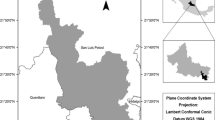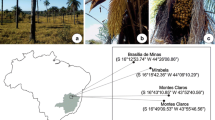Abstract
Calaverita an endangered Mexican orchid is one of the most elegant and showy orchids of the genus Laelia and essential symbol within the local traditional celebrations of the Day of the Dead, in the region of Chilapa-Guerrero. We investigated morphological variation in flowers of la calaverita (Laelia anceps Lind. subsp. dawsonii (J. Anderson) Rolfe f. chilapensis Soto-Arenas, Orchidaceae) using the labellum of the specimens cultivated in traditional home gardens in the region of Chilapa, Guerrero, Mexico. The use of morphometric traits of the labellum is useful in appraising infra-subspecific morphological variation within the chilapensis form. Floral morphological variation exists among the specimens examined. These specimens, found exclusively in traditional home gardens, were grouped into four morphotypes: NAT, Topiltepec, Xulchuchío, and Terrero. The study of variation of la calaverita revealed the existence of four local morphotypes that originated from a long and complex process of selection of traits which responds to traditional preferences and knowledge about specific biotic and agroecological conditions. The cultural and aesthetic influence of traditional homegarden owners in the Chilapa region acts directly on selection, use and conservation of the morphological traits of la calaverita.



Similar content being viewed by others
References
Ackerman JD, Galarza-Pérez M (1991) Patterns and maintenance of extraordinary variation in the caribbean orchid Tolumnia (Oncidium) variegata. Syst Bot 16(1):182–194
Anderson EN (1993) Southeast Asian Gardens: nutrition, cash and ethnicity. Biótica 1:1–11
Armbruster WS (2002) Can indirect selection and genetic context contribute to trait diversification? A transition-probability study of blossom colour evolution in two genera. J Evol Biol 15:468–486
Borba EL, Funch RR, Ribeiro PL, Smidt EC, Silva-Pereira E (2007) Demography, and genetic and morphological variability of the endangered Sophronitis sincorana (Orchidaceae) in the Chapada Diamantina, Brazil. Plant Syst Evol 267:129–146
Catling PM (1990) Malaxis salazarii, a new species from Mexico and northern Mesoamerica. Orquidea 12(1):93–104
Chávez JL, Collado PLA, Ramírez PR (2004) Conservación o pérdida del valor de las variedades locales de los cultivos amazónicos. In: Eguren F, Remy MI, Oliarte P (Eds) SEPIA X, Seminario permanente en investigación agraria. Sepia X, pp 503–537
Clegg MT, Durbin ML (2000) Flower color variation: a model for the experimental study of evolution. Proc Natl Acad Sci USA 97:7016–7023
Collado PLA (2002) Diversidad cultivada y socio-cultural en la Amazonía central del Perú. Master Dissertation. Escuela de Postgrado, Universidad Nacional Agraria de la Selva, Tingo María, Perú
CONABIO (2009) Comisión Nacional para el Uso de la Biodiversidad Cartas temáticas. In: Metadatos y cartografía. Comisión Nacional para el Uso de la Biodiversidad. Available via DIALOG http://www.conabio.gob.mx Cartas temáticas. Accessed 12 Feb 2009
De Jong W (1995) Diversity, variation, and change in Ribereño agriculture and agroforestry. Dissertation Wageningen, Thesis Landbouwuniversiteit Wageningen
Díaz BM, Herrera-Cabrera E, Ramírez-Juárez J, Aliphat-Fernández M, Delgado-Alvarado A (2008) Conocimiento campesino en la selección de variedades de haba (Vicia faba L.) en la sierra norte de Puebla México. Interciencia 33(8):110–115
Emigh TH, Goodman MM (1985) Multivariate analysis in nematode taxonomy. In: Barker KR, Carter CC, Sasser JN (eds) An advanced treatise on meloidogyne, vol II. Dept. of Plant Pathology, NCSU, North Carolina, pp 197–204
Herrera-Cabrera BE, Castillo-González F, Ortega-Pazkca RA, Sánchez-González JJ, Goodman MM (2000) Caracteres morfológicos para valorar la diversidad entre poblaciones de maíz en una región: caso la raza Chalqueño. Revista Fitotecnia Mexicana 23:335–354
Herrera-Cabrera BE, Castillo-González F, Sánchez-González JJ, Hernández-Casillas JM, Ortega-Pazkca RA, Goodman MM (2004) Diversidad del maíz chalqueño. Agrociencia 38(2):191–206
Hunter ML (1996) Fundamentals of conservation biology. Blackwell Science, Cambridge, MA, p 482
Judd W, Campbell C, Kellogg E, Stevens P (1999) Plant systematics a phylogenetic approach. Sinauer Associates Inc, Sunderland, p 464
Mascó M, Noy-Meir I, Sersic AN (2004) Geographic variation in flower color patterns within Calceolaria uniflora Lam. in Southern Patagonia. Plant Syst Evol 244:77–91
Norma Oficial Mexicana NOM-059-ECOL-2001 (2009) Protección ambiental-Especies nativas de México de flora y fauna silvestres Categorías de riesgo y especificaciones para su inclusión, exclusión o cambio. In: Lista de especies en riesgo. Instituto Nacional de Ecología. Available via DIALOG. http://www.ine.gob.mx/ueajei/publicaciones/normas/rec_nat/no_059.html Protección ambiental-Especies nativas de México de flora y fauna silvestres Categorías de riesgo y especificaciones para su inclusión, exclusión o cambio. Accessed 6 Jan 2009
Podolsky RH, Holtsford TP (1995) Population structure of morphological traits in Clarkia, Dudleyana I, comparison of Fst between allozymes and morphological traits. Genetic 140:733–744
Salazar-Rojas VM, Herrera-Cabrera E, Flores-Palacios A, Ocampo-Fletes I (2007) Traditional use and conservation of the “calaverita” Laelia anceps subsp. dawsonii f. chilapensis Soto-Arenas at Chilapa Guerrero México. Lankesteriana 7(1–2):368–370
SAS (2002) SAS/STAT Users guide, version 9. SAS Institute Inc, North Carolina
Schemske DW, Bierzychudek P (2001) Perspective: evolution of flower color in the desert annual Linanthus parryae: wright revisited. Evolution 55:1269–1282
Sneath PHA, Sokal RR (1973) Numerical taxonomy, the principles and practices of numerical classification. WH Freeman and Co, San Francisco, p 573
Soto-Arenas MA (1993) Clasificación infraespecífica de Laelia anceps. Orquídea 13(1–2):125–144
Author information
Authors and Affiliations
Corresponding author
Rights and permissions
About this article
Cite this article
Salazar-Rojas, V.M., Edgar Herrera-Cabrera, B., Soto-Arenas, M.Á. et al. Morphological variation in Laelia anceps subsp. dawsonii f. chilapensis Soto-Arenas Orchidaceae in traditional home gardens of Chilapa, Guerrero, Mexico. Genet Resour Crop Evol 57, 543–552 (2010). https://doi.org/10.1007/s10722-009-9492-5
Received:
Accepted:
Published:
Issue Date:
DOI: https://doi.org/10.1007/s10722-009-9492-5




